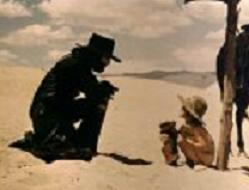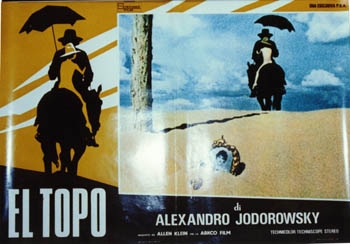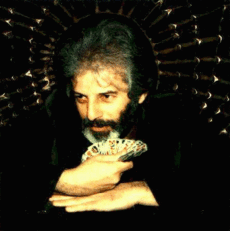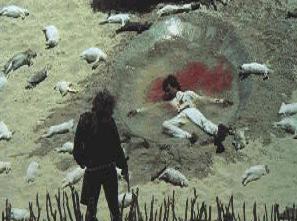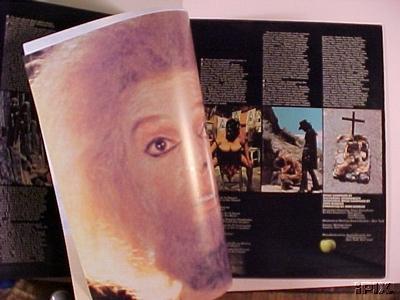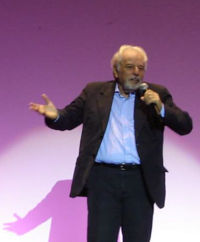 | El Topo, also knowen as "The Mole", 1971, Directed by Alejandro Jodorowsky |
|
|
|
Alejandro Jodorowsky |
|
|
|
2006 |
El Topo (The Mole) is a 1970 Mexican allegorical, cult western movie and underground film, directed by and starring Alejandro Jodorowsky. Characterized by its bizarre characters and occurrences, use of maimed and dwarf performers, and heavy doses of Christian symbolism and Eastern philosophy, the film is about the eponymous character - a violent, black-clad gunfighter - and his quest for enlightenment.
Alejandro Jodorowsky (Alexandro) (born February 7, 1929, in Tocopilla, Chile) is actor, director, producer, composer, mime, comic book writer and psychotherapist born to Ashkenazi Jewish parents of Russian origin. In 1973 he adopted the Mexican citizenship, but some years later he was naturalized as French.
He is particularly known for having directed a handful of esoteric, surreal and shocking films, and for having written several comic books.
Jodorowsky once said, "Most directors make films with their eyes. I make films with my cojones (testicles)."
"El Topo" (1970) is a mystical western, his second film, now considered a cult classic. John Lennon and Yoko Ono helped arrange the film''s release and distribution in the United States.)
www.en.wikipedia.org
Plot Summary: The gunfighter El Topo ("The Mole") and his young son ride through a desert to a village, whose inhabitants have been massacred. Bandits are nearby, torturing and killing the survivors. El Topo rescues a woman (Mara), who leads him on a mission to find and defeat the four master gunmen of the desert. Leaving his son with a group of monks, El Topo and Mara complete the mission, accompanied by a mysterious woman in black. The women leave El Topo wounded in the desert, where he is found by a clan of deformed people who take him to the remote cavern where they live. Awakening years later, he goes with a dwarf woman to a nearby town, promising to dig a tunnel through which the cave-dwellers can escape. They find the town run by a vicious sheriff and home to a bizarre religious cult. El Topo''s son, now a man, is a monk in the town. The completion of the tunnel leads El Topo, the townspeople, and the cave-dwellers to a bloody and tragic end.
Summary written by Marty Cassady
www.imdb.com
El Topo, Alejandro Jodorowsky''s cult film classic caused quite a commotion in the early 70s for its graphic violence and sensuality, in addition to its bizarre, surrealistic imagery. Jodorowsky, a Chilean filmmaker of Russian-Jewish birth is perhaps one of the most celebrated of the obscure filmakers; among his other films are the equally controversial films Santa Sangre and The Holy Mountain.
''El Topo'' in English means ''The Mole''. This character is a lonely gunfighter who travels around a desert searching for four masters that he feels he must battle with to achieve true greatness.
The first half of the film plays like a standard western, filmed with spectacular open vistas, authentic looking settings, gunfights and blood spiced up with unexplained kinky acts of sexuality and bizarre behavior. The second half of the movie abandons the conventions of the western genre and becomes more of a symbolic quest film.
If there is any possible interpretation to the endless journey of El Topo, it appears that Jorodowski is showing us that El Topo frequently uses violent means to achieve his goal raising the question as to if any of the characters El Topo fights against actually are evil. Initially his adversaries are clearly twisted and deserve their comeuppance. But as El Topo''s journey continues, his adversaries seem less and less threatening and less deserving of their fate. I am assuming that Jorodowski is telling us that because of El TopoÆs desire to kill these "masters" by resorting to primal brutality, he slowly loses his humanity.
Stylistically Jorodoski uses some very interesting techniques. He mixes unusual elements of the audio; the loud laughter of the villains that goes on forever, at other times there''s only the sound of the wind and the chirping of crickets. Jorodowski can also produced some striking images: An armless man carries a human torso in his back, the parade of freaks and little people who live underground in the vast desert, a group of priests waltzing with a gang of thieves in the middle of a village square, etc. But only images donÆt make a film. Jorodowski uses lots of symbolism reminiscent to the work of Luis Bunuel to support his story, but the filmÆs sketchy structure and lack of any character development adds up to a lot of nothing. Aside some striking images and tableaus the viewer becomes ultimately numbed and even worse bored. This approach emphasizes the dream quality of the world presented but the film, as stylistically interesting as it is sometimes , ultimately numbs the viewer to the point of ennui.
I have nothing against surreal and dream movies. Some of my favorite movies of all times are BunuelÆs The Discreet Charm of the Borgeoise and David LynchÆs Eraserhead. These films used symbolic images within the context of dreams to enlighten us. The difference between those films and EL Topo has a lot to do with a director that cares or not for their audience without underestimating their intelligence. A successful dream movie needs to have certain logic within itself to become accessible to an audience. An unsuccessful dream movie is that in which its logic lays on unjustified excesses and disregard for an audience.
ADDED NOTE: El Topo became a massive word of mouth success when it opened in New York in 1971. It became a midnight cult phenomenom until Allen Klein, the Beatles manager bought the rights to the film. Klein booked the film for several succesful screen viewings and since then has refused to release the film in any form. El Topo is available only in generation bootlegs or imported laser discs from Japan. For more information regarding finding El Topo email via The Spinning Image site.
Alejandro Jodorowsky
Review
INTERNATIONAL LANGUAGE AND CULTURE PROJECT
ULTRARARE FILM SOUNDTRACKS
